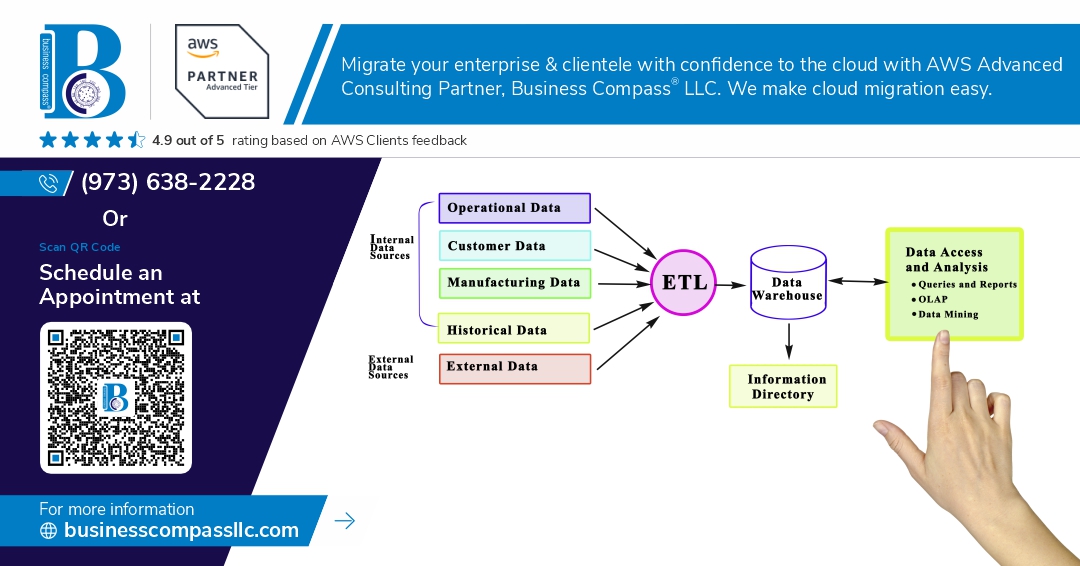Designing effective ETL (Extract, Transform, Load) workflows in AWS can make or break your data processing pipeline. For data engineers, cloud architects, and DevOps professionals managing growing datasets, a well-structured ETL process is essential for timely insights and analytics.
This guide walks you through proven AWS ETL workflow designs that scale with your data needs. We’ll cover architectural patterns for building resilient pipelines that handle massive datasets without performance degradation. You’ll also learn data transformation techniques that maximize efficiency while minimizing compute costs.
Let’s dive into the practical steps for creating ETL workflows that deliver clean, reliable data exactly when your organization needs it.
Understanding AWS ETL Fundamentals
Key ETL Components in AWS Ecosystem
The AWS ecosystem offers a robust set of ETL tools that work together seamlessly. At its core, you’ll find three primary components:
- Data Storage Services: Your data needs a home before and after processing.
- S3 buckets for raw data landing zones
- RDS or Aurora for relational data
- DynamoDB for NoSQL needs
- Redshift for data warehousing
- Processing Engines: These do the heavy lifting of your transformations.
- Glue for serverless ETL
- EMR for big data processing
- Lambda for lightweight transformations
- Kinesis Data Analytics for streaming transformations
- Orchestration Tools: Something needs to coordinate all these moving parts.
- Step Functions for complex workflows
- EventBridge for event-driven pipelines
- Airflow on MWAA for DAG-based orchestration
Choosing the Right AWS ETL Services for Your Needs
Picking the right tools makes all the difference between a smooth-running pipeline and a maintenance nightmare.
For batch processing with structured data, AWS Glue shines. It’s serverless, scales automatically, and handles most transformation needs without breaking a sweat.
For real-time processing, Kinesis is your go-to. Pair it with Lambda for simple transformations or Kinesis Data Analytics for complex stream processing.
For massive data volumes, EMR gives you the raw power of Spark, Hive, and other big data frameworks without the infrastructure headaches.
| Scenario | Best Service | Why It Works |
|---|---|---|
| Simple scheduled jobs | Glue | Low maintenance, pay-per-use |
| Streaming data | Kinesis + Lambda | Real-time processing power |
| Complex transformations | EMR | Distributed computing muscle |
| Microservice integration | Step Functions + Lambda | Flexible coordination |
Cost Optimization Strategies for AWS ETL Workflows
AWS ETL can get expensive fast if you’re not careful. Smart teams keep costs down with these approaches:
Right-size your resources. Glue jobs don’t always need 10 DPUs. Start small and scale up only when needed.
Use spot instances for EMR clusters. They can slash your compute costs by up to 90% for non-critical workloads.
Implement data partitioning to process only what you need. Don’t scan a whole S3 bucket when you only need yesterday’s data.
Set auto-termination for all your processing resources. Nothing drains your budget faster than idle clusters running for days.
Compress data in transit and at rest. Less data means lower storage costs and faster processing times.
Cache frequently used data with ElastiCache or DAX to reduce repeated processing of the same information.
Architecting Scalable ETL Pipelines
Designing for Horizontal Scaling
Building AWS ETL pipelines that grow with your needs isn’t just nice—it’s essential. Horizontal scaling means adding more machines rather than beefing up existing ones. On AWS, this translates to spinning up additional instances or containers when your workload spikes.
The key? Design your ETL components as stateless microservices from day one. Each function should handle a specific transformation task without depending on previous runs. This way, you can run multiple copies of the same component simultaneously without conflicts.
Amazon EMR with Spark clusters automatically scales based on your processing needs. Same goes for AWS Glue jobs—they dynamically allocate resources. Set up your infrastructure using AWS CloudFormation or Terraform to make scaling reproducible and painless.
Implementing Parallel Processing
Raw processing power only takes you so far. Smart parallelization is where the magic happens.
Break your ETL tasks into independent chunks that can run simultaneously. For instance, if you’re processing customer data, partition by region, date range, or customer segments.
# Pseudo-code for a partitioned Glue job
def process_data(partition_key):
data = get_data_for_partition(partition_key)
transformed = apply_transformations(data)
write_to_destination(transformed)
AWS Step Functions excel at orchestrating parallel workloads. You can fan out to process multiple partitions concurrently, then fan in to consolidate results.
When handling large datasets, use dynamic frame partitioning in Glue or partition pruning in Athena queries to process only relevant data slices.
Managing State and Dependencies
Even distributed pipelines need to keep track of what’s happening. The trick is making state management itself scalable.
Ditch local files for tracking progress. Instead, use DynamoDB to record job status, processing markers, and dependencies. Its virtually unlimited throughput scales with your pipeline.
For job orchestration, AWS Step Functions maintains execution state for you, handling retries and errors gracefully. Define clear input/output contracts between pipeline stages to avoid tight coupling.
Implement idempotent processing wherever possible—your functions should produce the same result regardless of how many times they run. This makes retries and recovery much more reliable.
Handling Varying Data Volumes Efficiently
Data volume fluctuations can wreck poorly designed pipelines. Your system needs to handle both trickles and floods.
For sporadic large batches, consider a combination approach:
- Use AWS Lambda for small files (under 256MB)
- Automatically switch to EMR or Glue for larger datasets
- Implement backpressure mechanisms to prevent downstream systems from getting overwhelmed
Dynamic resource allocation is your friend here. Configure auto-scaling policies based on queue depth or processing lag metrics.
Don’t forget to implement circuit breakers. When dependent systems become unresponsive, your pipeline should gracefully pause rather than fail completely.
Cost efficiency matters too. Design your pipeline to scale down to near-zero resources during quiet periods. Serverless components like Lambda and Glue can drastically reduce costs when idle compared to always-on EMR clusters.
Data Extraction Best Practices
Optimizing Source Connections
The backbone of any AWS ETL pipeline is how you connect to your data sources. Most ETL failures happen right at the start – when you’re trying to grab the data.
Want to avoid that headache? Design your source connections with these principles:
- Use connection pooling when hitting databases frequently. AWS Glue supports this natively, saving you from creating new connections for every extraction.
- Implement retry logic with exponential backoff. Sources go down. That’s life. But your pipeline shouldn’t crash when they do.
- Cache connection parameters in AWS Secrets Manager instead of hardcoding them in your scripts. This approach lets you rotate credentials without updating code.
# Example using Secrets Manager in AWS Glue
secret = secretsmanager.get_secret_value(SecretId='db-credentials')
connection_params = json.loads(secret['SecretString'])
Implementing Change Data Capture (CDC)
CDC is a game-changer for ETL workflows. Rather than pulling all your data every time, you only extract what’s changed.
AWS gives you multiple CDC approaches:
- DMS with CDC: Captures changes from RDS or on-prem databases in real-time
- Kinesis for streaming CDC: Perfect for high-volume transactional systems
- S3 event notifications: For file-based change detection
The performance difference? Massive. One client’s full extraction took 4 hours. Their CDC implementation? Just 3 minutes.
Balancing Batch vs. Real-time Extraction
This isn’t an either/or situation. Smart ETL architects use both:
- Batch extraction works best for:
- Historical data loads
- Reporting systems with defined refresh windows
- Cost-sensitive operations
- Real-time extraction shines when:
- Decision-making needs fresh data
- Detecting anomalies quickly matters
- Customer-facing analytics are involved
Many AWS pipelines use Lambda and Kinesis for real-time needs while keeping Glue jobs for nightly batch processes.
Ensuring Source System Performance
Your ETL process shouldn’t crash the systems it extracts from. Trust me, that makes you very unpopular with application teams.
Smart extraction techniques include:
- Throttling requests to match source system capacity
- Scheduling extractions during low-usage periods
- Partitioning queries to distribute database load
For RDS sources, monitor CloudWatch metrics during extraction to catch performance issues before they become problems.
And remember – always communicate with source system owners before implementing any high-volume extraction process. That conversation can save you countless headaches down the road.
Transformation Techniques for Maximum Efficiency
Serverless Transformation with AWS Lambda
Lambda functions are game-changers for ETL transformations. They spin up in milliseconds, run your code, then disappear – no servers to manage, no capacity planning headaches.
For quick transformations that don’t need massive computing power, Lambda is your best friend. Think of tasks like:
- JSON flattening
- Field normalization
- Simple data enrichment
- Format conversions
The magic happens when you chain Lambda functions together. Each one does one thing really well:
def transform_customer_data(event, context):
# Get data from S3 event
records = extract_from_s3(event)
# Apply business logic transformation
transformed = normalize_phone_numbers(records)
# Write back to destination
write_to_destination(transformed)
return {"status": "success", "records_processed": len(records)}
But watch out for Lambda’s limits – 15-minute runtime and memory constraints can trip you up with larger datasets.
Leveraging AWS Glue for Complex Transformations
When Lambda starts gasping for air, Glue steps in. This managed Spark environment handles the heavy lifting for complex transformations.
Glue shines with:
- Joining multiple large datasets
- Machine learning transformations
- Complex aggregations
- Heavy data processing jobs
The coolest part? You can write your transformations in Python or Scala and Glue translates them into optimized Spark jobs. No need to be a Spark expert:
# Sample Glue job that joins and transforms data
datasource = glueContext.create_dynamic_frame.from_catalog(
database="sales_db", table_name="raw_transactions")
customer_data = glueContext.create_dynamic_frame.from_catalog(
database="customer_db", table_name="customer_profiles")
joined_data = Join.apply(datasource, customer_data, "customer_id", "id")
transformed = ApplyMapping.apply(joined_data, mapping)
Glue even handles your ETL code in a version-controlled environment with built-in job scheduling.
Implementing Data Quality Checks
Garbage in, garbage out – it’s the eternal truth of data engineering.
Smart ETL workflows build quality checks directly into the transformation stage:
- Proactive validation: Stop bad data before it moves downstream
if not validate_data_structure(incoming_data): raise Exception("Invalid data structure detected") - Statistical profiling: Catch outliers and anomalies
mean_value = calculate_mean(numeric_column) if abs(current_value - mean_value) > 3 * std_deviation: flag_for_review(record_id) - Schema enforcement: Make sure data meets expected patterns
expected_schema = { "customer_id": "string", "purchase_amount": "decimal", "timestamp": "datetime" } validate_against_schema(data, expected_schema)
AWS Glue DataBrew offers visual data quality tools if you prefer a no-code approach.
Optimizing Memory and Computing Resources
ETL transformation costs can explode if you’re not careful. The trick is matching resources to your workload:
For Lambda:
- Start with 128MB memory and test upward
- Monitor duration metrics to find the sweet spot
- Use provisioned concurrency for predictable workloads
For Glue:
- Set worker type based on job characteristics:
Job Type Worker Type Worker Count Memory-intensive G.2X 5-10 CPU-intensive G.1X 10-20 Standard Standard 5-10 - Enable autoscaling but set reasonable limits
- Use job bookmarks to avoid reprocessing data
Partitioning is your secret weapon – split data logically (by date, region, etc.) so each transformation job processes a manageable chunk.
Schema Evolution Strategies
Data changes. Fields get added, removed, or modified. Your transformation layer needs to roll with these punches.
Smart approaches to schema evolution:
- Schema versioning: Tag each dataset with its schema version
output_data = { "schema_version": "2.1", "data": transformed_records } - Forward compatibility: Make transformations accept new fields without breaking
# Extract only the fields we need, ignore the rest required_fields = {k: record.get(k) for k in ['id', 'name', 'email']} - AWS Glue Data Catalog: Register schemas and track changes over time
- Schemaless intermediates: Use flexible formats like JSON for transformation stages
Always build transformations that fail gracefully when encountering unexpected fields rather than crashing the entire pipeline.
Loading Data Effectively
Optimizing Target Database Performance
The database at the end of your ETL pipeline can make or break your entire operation. If it can’t handle the incoming data tsunami, all your upstream work is wasted.
Start by choosing the right instance types. For high-throughput workloads on RDS, memory-optimized instances often outperform their general-purpose cousins. And please don’t skimp on IOPS – your database will thank you later.
Connection pooling isn’t optional – it’s essential. Each time your ETL process establishes a new connection, you’re burning precious milliseconds. Set up proper connection pooling to reuse these pathways and watch your load times shrink.
Indexing strategy matters enormously during loads. Consider temporarily dropping non-essential indexes during massive data inserts, then rebuilding them afterward. The performance difference can be staggering:
| Approach | 10M Row Insert | Index Rebuild | Total Time |
|---|---|---|---|
| With Indexes | 45 min | 0 min | 45 min |
| Without Indexes | 8 min | 12 min | 20 min |
Implementing Efficient Load Patterns
Batch loading beats row-by-row inserts every time. When working with Redshift, leverage the COPY command instead of INSERT statements – you’ll see 10-100x better performance.
Parallel loading is your secret weapon. Split your data into chunks and load simultaneously:
def load_partition(partition_data):
# Load a single partition to the target
with ThreadPoolExecutor(max_workers=5) as executor:
executor.map(load_partition, partitioned_data)
For dimensional data, merge operations (upserts) are often more efficient than separate insert/update statements. With DynamoDB, BatchWriteItem can process up to 25 items at once.
Managing Transaction Boundaries and Atomicity
Nothing frustrates users more than partially loaded data. Either all the data arrives or none of it should – there’s no middle ground.
Implement proper transaction boundaries around logical units of work. A simple approach:
BEGIN TRANSACTION;
-- Insert into dimension tables first
INSERT INTO dim_customer (...) VALUES (...);
-- Then fact tables
INSERT INTO fact_sales (...) VALUES (...);
COMMIT;
Consider staging tables for complex loads. Load all data to a temporary structure, validate it thoroughly, then swap the tables atomically. This technique minimizes the window when users might see incomplete data.
For truly massive datasets, implement checkpoint mechanisms. If a load fails halfway through, you’ll thank yourself for being able to resume from the last checkpoint rather than starting over.
Monitoring and Maintenance
Setting Up Comprehensive Monitoring Dashboards
Nobody likes being blindsided by ETL failures at 3 AM. That’s why proper monitoring is non-negotiable in AWS ETL workflows.
Start with CloudWatch dashboards that track essential metrics:
- Data volume processed
- Processing time by stage
- Error rates and types
- Resource utilization (CPU, memory, disk I/O)
Customize these dashboards for different stakeholders. Your data engineers need technical details, while managers need high-level health indicators.
AWS X-Ray comes in clutch for distributed tracing across your ETL components. It shows you exactly where things slow down or break.
Pro tip: Add business context metrics to your dashboards. Track things like cost per GB processed or data freshness. These metrics help justify your ETL investments to leadership.
Implementing Alerting for Critical Failures
Alerts that cry wolf get muted. Be strategic about what deserves a midnight text.
Set up a tiered alerting approach:
- P0 (Critical): Complete pipeline failure, data loss
- P1 (High): Significant delays, partial failures
- P2 (Medium): Performance degradation
- P3 (Low): Warnings, potential issues
Route these through SNS to the right channels – Slack for P2/P3, PagerDuty for P0/P1.
Create actionable alerts with context. “ETL job failed” is useless. “Order processing ETL failed at transformation stage with permission error” gives your on-call engineer a fighting chance.
Performance Tuning Methodologies
Your ETL pipeline is only as good as its slowest component. Finding bottlenecks requires methodical investigation.
Start with these tuning strategies:
- Partition data intelligently (by date/region/customer)
- Right-size your compute resources (EMR clusters, Glue DPUs)
- Cache frequently accessed reference data
- Compress intermediate data to reduce I/O
- Rewrite expensive transformations in optimized formats
For AWS Glue specifically, tune these often-overlooked settings:
- Worker type selection based on memory vs. CPU needs
- Number of workers and partitions
- Spark parameters like executor memory
Document your performance baseline before and after tuning. There’s nothing more satisfying than showing a 40% reduction in processing time.
Troubleshooting Common ETL Issues
When things break (and they will), you need a game plan.
Common AWS ETL failure points:
- Permissions: IAM roles missing access to S3, DynamoDB, etc.
- Resource constraints: Out of memory errors, timeout limits
- Data quality: Schema changes, unexpected null values
- Dependencies: Source API changes, network connectivity
For each issue, follow a systematic approach:
- Check logs (CloudWatch, S3 access logs)
- Validate configurations (IAM policies, network settings)
- Test with smaller data samples
- Replicate in development environment
Keep a runbook of common issues and solutions. Your future self will thank you when you’re debugging issues at midnight.
Remember – even the best ETL pipelines fail. The difference between good and great engineers is how quickly they can identify and resolve issues.
Security and Compliance in AWS ETL
Advanced ETL Patterns and Techniques
A. Implementing Slowly Changing Dimensions
Ever tried tracking how customer data changes over time? That’s where Slowly Changing Dimensions (SCDs) come in. In AWS, implementing SCDs doesn’t have to be a headache.
For Type 1 SCDs (where history isn’t preserved), a simple AWS Glue job can overwrite existing records. But most businesses need history, right?
For Type 2 SCDs, try this approach:
- Use DynamoDB to track the current version of each record
- When changes arrive, compare against this current state
- If different, create a new record in your data warehouse with AWS Glue
- Update your pointer in DynamoDB
# AWS Glue snippet for Type 2 SCD
def process_scd_type2(new_record, current_record):
if hash(new_record) != hash(current_record):
new_record['effective_date'] = datetime.now()
new_record['is_current'] = True
current_record['is_current'] = False
current_record['end_date'] = datetime.now()
return [current_record, new_record]
return [current_record]
B. Designing for Multi-Region Deployments
Multi-region ETL isn’t just for disaster recovery—it’s about performance and compliance too.
AWS Global Tables for DynamoDB give you multi-region replication out of the box. Pair this with regional S3 buckets and you’ve got data locality sorted.
The real magic happens with AWS Step Functions. Create regional state machines that coordinate your ETL workflows, then use Route 53 to direct traffic to the nearest healthy region.
Some gotchas to watch for:
- Data consistency becomes tricky
- Regional service differences can bite you
- Costs multiply quickly
My favorite pattern? Use S3 Cross-Region Replication for your data lake, but keep processing regional. This way, analytics teams get local performance while your disaster recovery stays solid.
C. Integrating Machine Learning in ETL Pipelines
Machine learning and ETL are a match made in heaven. Why just move data when you can enrich it too?
Start simple: add an AWS Lambda step that calls Amazon Comprehend to detect sentiment in your customer feedback data. Or use Amazon Translate to standardize multilingual data.
For more advanced needs, SageMaker fits perfectly in your AWS ETL workflow:
ETL Job → S3 Bucket → SageMaker Batch Transform → Enriched S3 Bucket → Redshift
Real talk: ML-enhanced ETL shines for:
- Anomaly detection (catch bad data before it hits your warehouse)
- Entity resolution (matching customer records without exact IDs)
- Data classification (automatically tagging sensitive information)
Pro tip: don’t rebuild your entire pipeline. Add ML incrementally where it adds the most value.
D. Event-Driven ETL Architecture
Traditional ETL runs on schedules. Event-driven ETL runs when it’s needed. Big difference.
AWS gives you all the tools to make this happen:
- S3 events trigger Lambda functions when new files land
- DynamoDB Streams capture table changes
- EventBridge connects SaaS apps to your ETL pipeline
The beauty? Your data warehouse stays fresher with minimal processing lag.
This architecture absolutely shines for real-time analytics. Imagine tracking website activity and having those insights available minutes later.
Here’s a simplified flow:
- User activity generates events
- Events hit Kinesis Data Streams
- Lambda consumes events and transforms data
- Processed data flows to Amazon Timestream
- QuickSight dashboards update in near real-time
One warning: debugging event-driven systems gets complex. Use AWS X-Ray to trace requests across services and CloudWatch to set up smart alerts when things go sideways.
Designing an effective ETL workflow in AWS requires careful consideration of architecture, scaling strategies, and best practices across the extract, transform, and load phases. By implementing proper data extraction techniques, efficient transformation processes, and optimized loading methods, organizations can build robust data pipelines that handle growing volumes while maintaining performance. Monitoring, security, and compliance measures ensure these systems remain reliable and protected.
As you implement your own AWS ETL solutions, remember that the most successful workflows balance immediate needs with future growth potential. Start with a solid foundation based on the fundamentals covered here, then gradually incorporate advanced patterns as your data requirements evolve. Whether you’re building your first ETL pipeline or optimizing existing workflows, these practices will help you create data integration systems that deliver timely, accurate insights while scaling efficiently with your business.



















